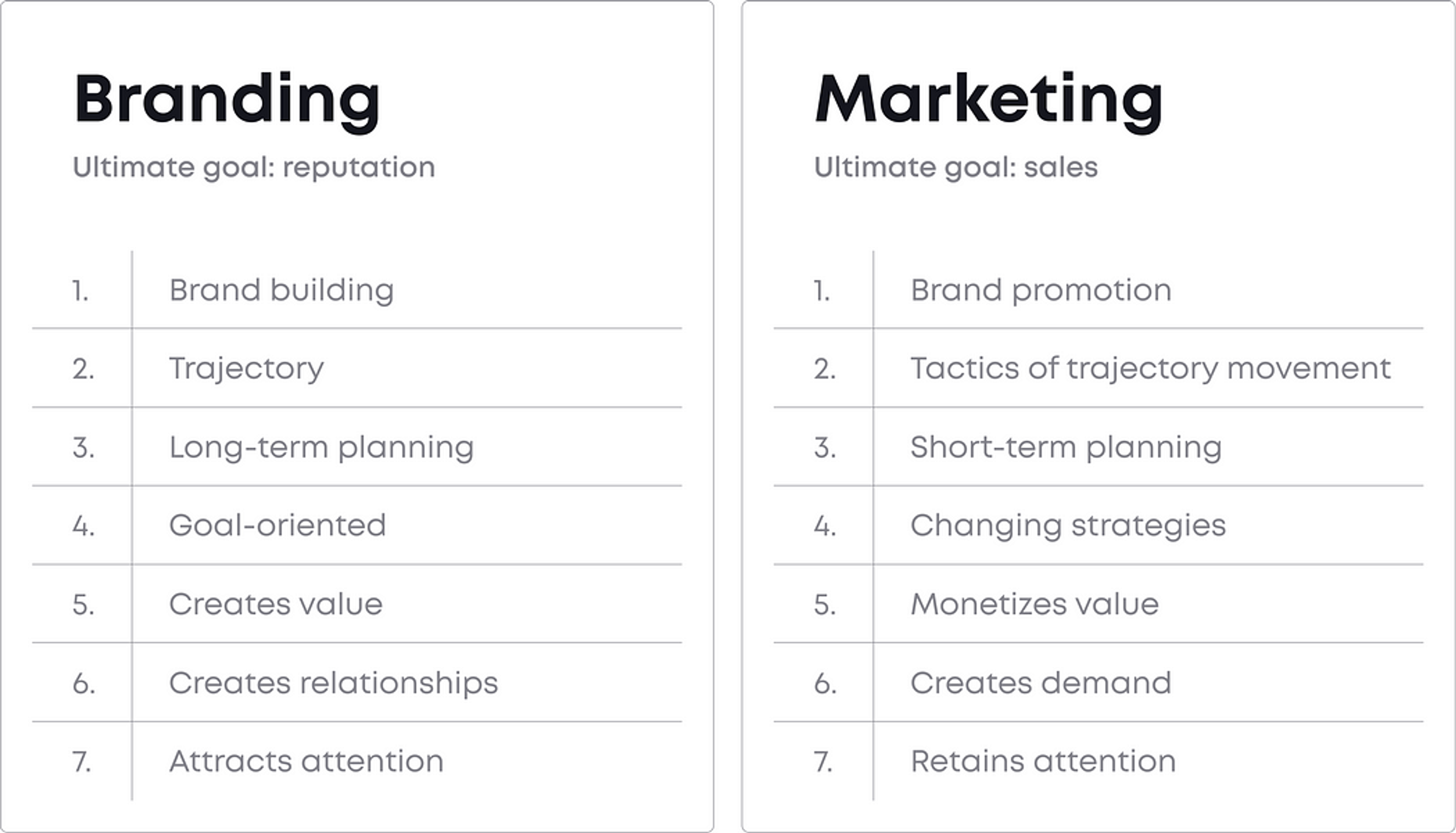The technology sector is highly competitive, which is why branding for startups is critical. A company with a proper brand is less likely to be overshadowed by its competitors and is more likely to capture the interest of investors and customers. To get the best results, it is recommended to contact branding agencies.
However, the situation is more challenging than it may sound, and there are significant hurdles to creating a brand for a startup in the technology space. This paper will discuss the critical importance of branding within the context of a technology startup.
We will discuss traditional branding methods and how they need to be more, and present figures that address the role of branding in the prepared technology industry. Let’s explore the secrets and techniques that will help startups from a technology background capture the target audience’s focus.
Source: blog.hubspot.com

Understanding the Tech Startup Branding Landscape
What Is Branding for Tech Startups?
Branding for tech startups is the process of creating a unique identity that communicates the essence of the startup, resonates with its target audience, and fosters long-term loyalty.
It involves crafting a visual identity, voice, and energy that set the startup apart from its competitors and establish a strong presence in the market.
Effective branding for tech startups is crucial for building trust, credibility, and recognition, ultimately driving growth and success. By developing a cohesive brand strategy, tech startups can ensure that their brand’s identity is consistently communicated across all touchpoints, from their website and social media to their product design and customer interactions.
Why Is Branding Important for Startups?
Branding is essential for startups as it helps to differentiate them from their competitors, establish a unique value proposition, and build trust and credibility with their target audience. A strong brand identity can increase customer loyalty, retention, and revenue, while also attracting top talent and investors.
In a competitive market, branding is a key differentiator that can make or break a startup’s success. By investing in a well-defined brand strategy, startups can create a compelling brand story that resonates with potential customers and stakeholders, ultimately leading to sustained growth and market presence.
Differentiating Branding from Marketing
Branding and marketing are often used interchangeably, but they serve distinct roles. Branding is about creating an identity that resonates with the target audience and fosters long-term loyalty, while marketing is about promoting products or services to drive immediate sales.
Understanding this distinction allows startups to allocate resources effectively, ensuring that both branding and marketing efforts work together to achieve business objectives.
While branding focuses on the overall perception and emotional connection with the brand, marketing efforts are geared towards tactical campaigns and strategies that generate leads and conversions.
Source: medium.com

Unique Challenges
Technology startups need help with branding owing to their target niche, which is constantly changing, and the intricacies of the products or services offered by the business. One of the specific areas of branding that most technology startups find themselves grappling with is branding.
Initiating branding efforts early is strategically important for tech startups to create a solid brand identity and capitalize on market opportunities. Some of the critical challenges of branding faced by technology startups include the following:
- Changes in the market condition along with technology: It is safe to argue that the tech industry is unsettled with innovation, market dynamics are vast, and startups must quickly appear to meet relevancy.
- Complex product/service to explain: Tech startups tend to require that their clients use specific products or services, even advanced technology, which may prove difficult to explain. Finding ways of simplifying and communicating to the potential customers’ audience, especially in more compelling brand messaging, becomes necessary.
- Competing priorities and lack of resources: Most of the time, resources are limited, and therefore, startup entities have to focus on core branding, which sounds essential as they attend to other crucial aspects of the business. To succeed, it is necessary to have an optimal mix of the various ingredients of the branding strategy.
- Innovation vs brand accessibility: Startups today are mainly about the next great idea, and their corporate image should embody that idea or at least be almost there. Businesses must find a way to get their corporate identity on the cusp of new technologies while remaining user-friendly.
- A plurality of the target audience (investors, customers, talent): Tech startups usually have talent acquisition, investors, and clients as the significant audiences to serve. This audience can have different priorities and perspectives, requiring young businesses to do tailored branding strategies that will suit each person.
To compete in the market and establish a strong brand presence, tech startups need to address these and more unique branding challenges.
Common Pitfalls
Building a brand is one of the primary duties of tech startups. However, setting up a strong brand takes work. Some of the challenges or common mistakes that tech startups should be careful to avoid are the following:
It's important to remember that branding involves much more than just a logo. It encompasses the entire customer experience and visual identity, requiring a cohesive brand strategy that resonates with customers and differentiates a company in a competitive market. Neglecting these broader elements can lead to missed opportunities and lost customers.
Source: designrush

Reliance on Stereotyped Tech Messages and Visuals
Using stereotyped tech messages and visual language often makes a startup blend in instead of standing out when it is most needed, which can spell trouble for the startup in the long run. Messaging and visuals should be unique to the brand rather than one that can be mistaken or shared with another company.
Brand Identity Fragmentation
When brand identity is fragmented and not homogenous, it is difficult for the audience to comprehend the brand message fully and creates confusion.
Tech startups need to ensure that the way they talk about their breeding remains the same regardless of the platform—website, social networks, printed and online ads, and even conversations with customers.
Premature Scaling of Brand Initiatives
One of the mistakes of many novice firms is trying to expand their brand initiatives when there is no reason to do so. They must sit tight first and work on strengthening the brand's core, getting to know the audience, and fine-tuning its strategies.
Neglecting Emotional Connections with Users
While technology is often associated with logic and practicality, neglecting the emotional aspect of branding can be a missed opportunity. Establishing emotional connections with users through storytelling, empathy, and human-centered design can foster long-lasting relationships and loyalty.
By being aware of these common pitfalls and proactively addressing them, tech startups can refine their branding strategies and create a strong, compelling, and differentiated brand presence in the competitive market.
Building a Strong Tech Startup Brand
Foundation Elements
Building a solid brand for your tech startup is easier when you have a foundation that is consistent with your vision and has an appeal to the right audience. Here are the key aspects that you should consider:
Establishing an authentic brand purpose and vision: You need to state your mission and the role you want to play in the tech space. End with a vision statement that explains your startup’s goals and motivates everyone involved.
Source: mapandfire.com

Articulating the core priorities and the competitive edge: Figure out the core values that your startup is living for and values that make you better than the competition. They will bring cause and distinction to how your brand stamp will look like.
Brand positioning is crucial in establishing your brand's place in the market relative to competitors. A well-defined brand positioning influences how your target audience perceives your brand and helps differentiate it within a competitive landscape.
In doing so, you will be able to focus on these foundational components, which will give you a strong base on how your tech startup brand should be so that you can deliver your brand message and connect with your audience.
Communication Approaches
Effective communication is also crucial as it allows the founder of the tech startup to deliver a message targeted to the audience. Strong branding plays a vital role in this process by ensuring consistent messaging and fostering customer loyalty. Below are some points to consider in improving your communication strategies:
Making difficult words’ meanings easy: Reduce the definition of legal words into simple words that target audiences can relate to. Use photos and videos in your communication to make your point more straightforward.
Using too much jargon and too little of it: Know when to use technical jargon to demonstrate your expertise and when not to because it may confuse the audience. Please customize the language you will use, especially the technical words, to your audience’s understanding.
Thus, by applying these strategies, you can market your tech startup and its value proposition, earn your audience’s trust, and help them visualize your brand differently.
Channel-Specific Tactics
To effectively market and reach your desired audience, it is essential to employ various platforms and actions suitable for the respective platform. Let's suggest some quite useful platform-oriented actions:
Website and Other Digital Engagement
A typical tech startup website must be a good platform for the Marketing assistance that a startup seeks. It should be nice-looking, informative, and easy to navigate.
Depending on SEO patterns, traffic is generated to the site without advertising costs, an added advantage for the site owner. Interactive content, videos, and case studies can also emphasize the tech solutions offered and improve the user experience.
Social Media Strategy
1.
Identify and apply the best platforms to expand your business's reach and connect with your customers.2.
Use social media sites relevant to the users you want to reach, whether LinkedIn, Twitter, or Instagram, and adapt the message to each platform.3.
To effectively connect the company with its customers, it should have images to share about the business, such as product launches and other essential insights.
Interact with the audience via comments, DMS, and through features like polls or Q&A.
Source: sitecentre

Developer Relations
1.
If your tech startup is building products for developers or taking advantage of developer communities, allocate resources to developer relations.2.
Attend developer events such as conferences, run or sponsor hackathons or workshops, and create and publish detailed documentation and other helpful resources for developers.3.
Build and engage with developers by establishing a community and integrating with them through forums, meetups, and online communities.
Community Building
One of the primary objectives should be to grow a solid and supportive community around your tech business and allow interactions for networking, knowledge transfers, and mentorship.
Create a forum for your community, organize online events or webinars, and promote user content and conversations. Communicate and interact with community members regularly to build their loyalty and attachment to the brand.
These channel-specific techniques can help you locate and connect with the right audience, position your tech startup business as a trusted voice in the industry, and build a strong and very loyal customer base.
Measuring Brand Success
Key Metrics
A few essential metrics determine a brand's success, allowing a business to gauge and assess how effective its branding has been. The metrics give you insight into how successful your branding has become and help you take informed action in improving your brand if required. While several key metrics should be kept in mind, these are the essentials:
Brand Awareness and Recall
Evaluate the extent to which the target audience is aware of and can recall your brand. This can be done through surveys, brand awareness studies, or even analyzing the amount of social media activity and discussion relevant to your target audience.
Usership and User Sentiment
Use analytics tools to measure engagement and see how often users engage with your brand on various channels such as social media, websites, or in direct communications with customers.
You can also see sentiment through customers' reviews and ratings or use sentiment analysis techniques to measure how people feel about your brand.
Source: chisellabs

Customer Acquisition Costs
The new Customer Acquisition cost (CAC) is the latest customer's new metrics that, together with marketing costs, dispersed advertisement campaigns, and costly sales efforts, acquire a new customer.
This metric of measuring customer acquisition cost helps ascertain how effective and efficient your marketing and selling strategies were.
Investor Interest and Valuation Impact
Measure the degree of interest your brand achieves among investors and the brand's ability to affect the company's value. Understand the dynamics of investor relations and funding rounds to assess confidence and the weight your brand carries within the investor community.
Monitoring and analyzing these key performance indicators on a regular basis should help you gain an understanding of how effective and impactful the brand is. This knowledge can, therefore, help you make business decisions that will lead to more growth and sustainability for the tech startup.
Adaptation Framework
The Adaptation Framework is a tactical framework that allows your tech startup to evolve with the changing business environment. By being flexible, your brand will also be able to respond to changes in market conditions, customer requirements, and trends that are on the rise. Here are the components of the Adaptation Framework:
Periodic Evaluations of Your Brand
The objective is to determine your brand's status in relation to the audience you are targeting. Brand-related studies, including brand acceptance on the market or among potential customers, brand performance against competition or general industry performance, etc., should help brand owners identify what needs to be done and what opportunities exist.
Systems for Continuous Feedback Mechanism
If possible, create systems that enable the collection of feedback and complaints from and about clients, employees, and stakeholders. Use surveys, interviews, or even social listening to understand them even more and what they want or expect from you. This is very helpful where a blue ocean strategy has been adopted and the brand and its offerings even change.
Read more:
Conclusion
In conclusion, in the ever-evolving tech industry, branding plays a vital role in shaping the success of startups. By following the strategies outlined in the Adaptation Framework, startups can navigate the complexities of the market, build a strong brand identity, and establish a competitive edge.
It is crucial to invest in understanding your target audience, prioritize continuous innovation, and foster a culture of resilience and adaptability.
With a well-defined brand strategy, effective crisis management plans, and a forward-thinking mindset, startups can thrive in an ever-changing landscape. Embrace the power of branding, stay agile, and seize the opportunities that lie ahead to create a lasting impact in the tech world.


About Clay
Clay is a UI/UX design & branding agency in San Francisco. We team up with startups and leading brands to create transformative digital experience. Clients: Facebook, Slack, Google, Amazon, Credit Karma, Zenefits, etc.
Learn more

About Clay
Clay is a UI/UX design & branding agency in San Francisco. We team up with startups and leading brands to create transformative digital experience. Clients: Facebook, Slack, Google, Amazon, Credit Karma, Zenefits, etc.
Learn more


